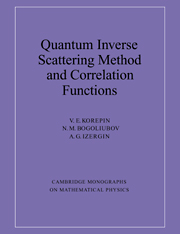Book contents
- Frontmatter
- Contents
- Preface
- Part I The Coordinate Bethe Ansatz
- Part II The Quantum Inverse Scattering Method
- Introduction to Part II
- V The Classical r-matrix
- VI The Quantum Inverse Scattering Method
- VII The Algebraic Bethe Ansatz
- VIII Lattice Integrable Models of Quantum Field Theory
- Part III The Determinant Representation for Quantum Correlation Functions
- Part IV Differential Equations for Quantum Correlation Functions
- Final Conclusion
- References
- Index
VIII - Lattice Integrable Models of Quantum Field Theory
Published online by Cambridge University Press: 04 August 2010
- Frontmatter
- Contents
- Preface
- Part I The Coordinate Bethe Ansatz
- Part II The Quantum Inverse Scattering Method
- Introduction to Part II
- V The Classical r-matrix
- VI The Quantum Inverse Scattering Method
- VII The Algebraic Bethe Ansatz
- VIII Lattice Integrable Models of Quantum Field Theory
- Part III The Determinant Representation for Quantum Correlation Functions
- Part IV Differential Equations for Quantum Correlation Functions
- Final Conclusion
- References
- Index
Summary
Introduction
Lattice variants of integrable models, both classical and quantum, are formulated in the present chapter. The nonlinear Schrödinger (NS) equation and the sine-Gordon (SG) model are considered. QISM makes it possible to put continuous models of field theory on a lattice while preserving the property of integrability. In addition, the explicit form of the R-matrix is kept unchanged; this means that the structure of the action-angle variables for the classical models is unchanged. For quantum models, the analogue is the preservation of the S-matrix (see the end of section VII.7). The critical exponents, which characterize the power-law decay of correlators for large distances, are also preserved. For relativistic models of quantum field theory, lattice models may be used to rigorously solve the problem of ultraviolet divergences. The construction of local Hamiltonians for lattice models in quantum field theory is given much attention in this chapter. It is of interest to note that the L-operators of lattice models depend on some additional parameter Δ (which is absent in the R-matrix). This is the lattice spacing. However, the L-operator can be continued in Δ to the whole complex plane. Based on this fact, the most general L-operator may be constructed which is intertwined by a given R-matrix. This solves the problem of enumerating all the integrable models connected with a given R-matrix.
- Type
- Chapter
- Information
- Quantum Inverse Scattering Method and Correlation Functions , pp. 172 - 188Publisher: Cambridge University PressPrint publication year: 1993



